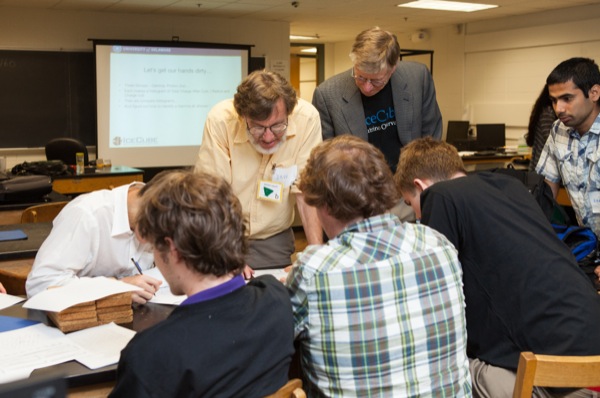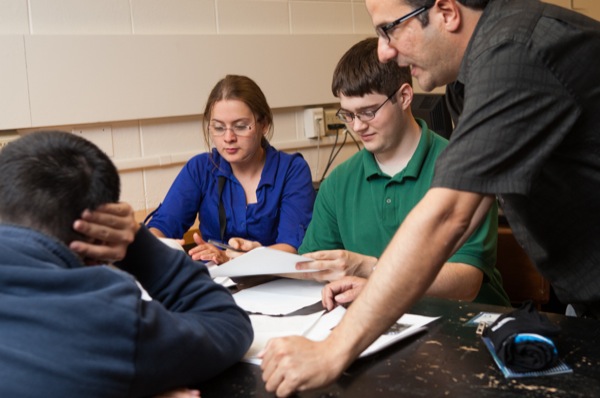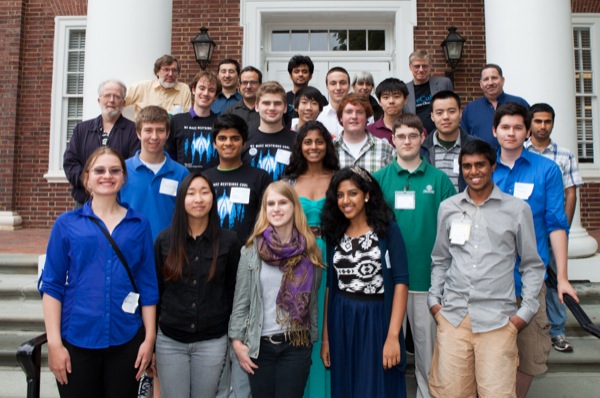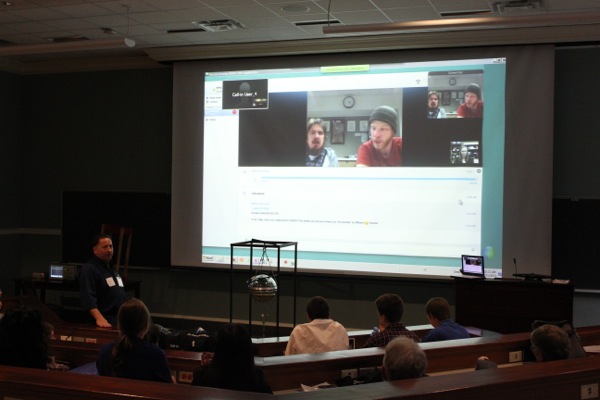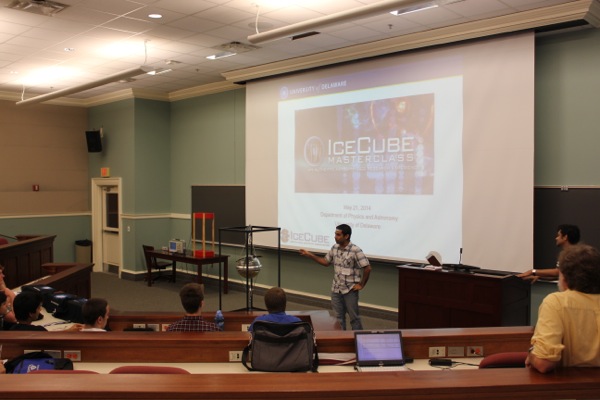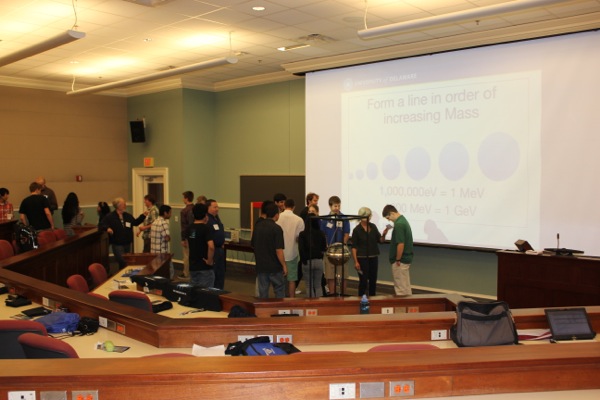

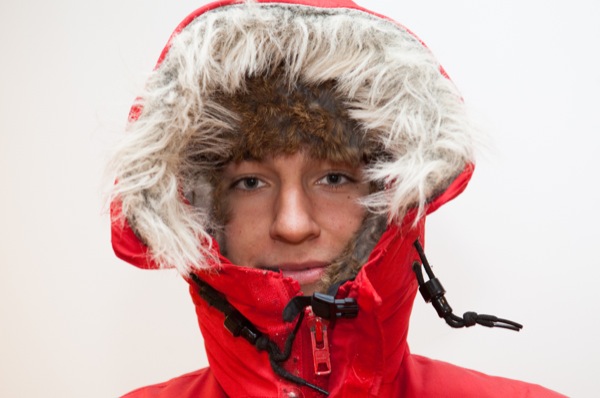
Polar master class
Charter school students participate in UD IceCube master class
1:04 p.m., June 5, 2014--About 20 students from the Charter School of Wilmington visited the University of Delaware on May 21 to participate in a master class highlighting the research efforts at the IceCube Neutrino Observatory located at the South Pole.
The morning program, held in Gore Hall, featured presentations by Thomas Gaisser, Martin A. Pomerantz Chair of Physics and Astronomy, and David Seckel, professor of physics and astronomy.
Campus Stories
From graduates, faculty
Doctoral hooding
IceCube is composed of 5,300 sensors, called digital optical modules, suspended along 86 cables embedded in a cubic kilometer of ice beneath the South Pole. It detects neutrinos through the tiny flashes of blue light, called Cherenkov light, produced when these tiny particles interact in the ice.
Gaisser led a team of researchers in UD’s Department of Physics and Astronomy who have been instrumental in constructing and maintaining the IceCube observatory’s surface array of detectors -- known as IceTop -- during the past decade.
“It took seven Antarctic seasons to build this technology,” Gaisser said. “The working time is from the end of October to around Valentine’s Day, then it becomes totally dark and too cold to fly planes in or out.”
Gaisser noted that the 86 holes melted in the ice by a hot-water drill at the South Pole are each 60 centimeters in diameter and extend to a depth of 2,450 meters.
The surface array includes an additional 324 DOMs frozen inside 162 IceTop tanks on the surface.
The DOMs help scientists rule out the interference caused by neutrinos produced locally in the atmosphere and to focus instead on more energetic particles produced light years away from Earth, possibly from the radiation field left over from the Big Bang, which most astronomers believe formed the universe.
“The point I want to make now is that the IceCube particle detector is in some ways a very crude version of the particle accelerator and detector at CERN (the European Organization for Nuclear Research facility along the border of France and Switzerland, near Geneva), except that it detects particles made not by machines but by objects in the universe,” Gaisser said. “It’s a detector for particles that come from cosmic accelerators.”
Different wavelengths have different colors, and the more blue the radiation, the more intense the light, Seckel noted.
“The light that is produced goes all the way from infrared, which you don’t see at all, to ultra violet. The question becomes what frequency light actually passes through the ice and can be seen by our cameras,” Seckel said. “The very red light doesn’t have enough energy to be seen by the DOMs, while the very ultraviolet light gets absorbed in the ice. Most of our signals come from the blue light.”
The Gore Hall classroom session also featured a particle game, in which individuals were assigned an elementary particle nametag listing mass, charge, flavor and color. Participants were asked to line up in the order of increasing mass to show the levels of particle interaction.
A call to the South Pole
High school students at locations in Wisconsin, Belgium and Germany joined their Charter School of Wilmington peers to participate via Skype in a question-and-answer conversation with South Pole “winter-overs” Dag Toppe Larsen and Ian Reese.
Larsen, who holds a doctorate in nuclear physics from the University of Bergen, Norway, has participated in a wide range of tasks for various experiments at CERN in Switzerland. Reese, originally from rural northern Georgia, has worked as a software developer for cellular communication networks and an electrical engineer working mainly with renewable energy.
Questions posed by the students at UD were forwarded to Larsen and Reese by James Roth, a UD senior electronics instrumentation specialist and veteran of many South Pole treks to install and maintain the IceTop tanks.
Students wanted to know what an average day at the station was like, and what types of difficulties come with wintering over.
“We get up early in the morning. Our meals are provided for us,” Reese said. “We usually check emails and that kind of thing to see if anybody has put in any requests and if there are any things that need fixing.”
“We have a crew of about 41 people here now, but sometimes I think it would be nice to see new people,” Larsen said. “There are all kinds of things that can break, and sometimes there are just random problems that come up.”
Students also were curious as to just how dark it really gets and how the weather at the South Pole can change at any given time.
“The outside light or darkness depends on what the moon is doing,” Reese said. “When the moon is up, it’s almost like daylight outside, because there is so much reflection from the snow.”
Reese also noted that when the wind changes, there can be a lot of snow blowing around, making “it is hard to see markers that are more than five meters away.”
Visiting students at UD wondered what would happen if a portion of the detector under the ice went bad, and how that situation would affect data collection.
“If it was below the ice, there would be no chance to dig that piece of equipment out,” Larsen said. “We would just work around that problem and start the detector without using the broken parts.”
When not working, Larsen noted that people enjoy things like movie night, games and popular television programs, or just enjoying the solitude and catching up on some reading.
Both Larsen and Reese said the cold weather presents problems in terms of both equipment failure and recreational activities.
“Basically, anything made out of plastic or rubber just doesn’t work outside. They tend to get brittle,” Reese said. “Computers don’t like being that cold, so we try to have heaters where some of the smaller experiments are taking place.”
Because the South Pole is about 9,000 feet above sea level, people sometimes have a hard time with sleeping and exercising in the station’s gymnasium, Larsen said.
“The air pressure changes quite a bit here,” Larsen said. “You really notice it when you are playing indoor soccer in the gym. If you are bringing a piece of equipment in from the cold it can be extremely brittle, so you have to sit it down and let it thaw out for 15–20 minutes before picking it up again.”
Analyzing the data
Following a break for lunch, the hosting faculty and graduate students conducted sessions in which visiting students analyzed data coming from the neutrino observatory to detect the signatures of neutrinos and where they came from.
“The students enjoyed the day and stayed engaged for all aspects,” Gaisser said. “I enjoyed the afternoon exercises and the chance to help the students understand our analysis.”
Physicists helping to make the day interesting and informative for their guests included research scientists Serap Tilav and Javier Gonzalez and postdoctoral researcher Bakhtiyar Ruzybayev. Graduate students participating included Ramesh Koirala and Hershal Pandya.
“I thought the visiting students seemed engaged in the afternoon when they were actually playing with data and trying to understand how physicists draw conclusions from the experiment,” Seckel said. “I enjoyed the conversations with small groups of students, trying to explain the details of what they were looking out and to see the enjoyment and effort our grad students took in participating.”
Article by Jerry Rhodes
Photos by Ambre Alexander Payne and courtesy of the Department of Physics and Astronomy




